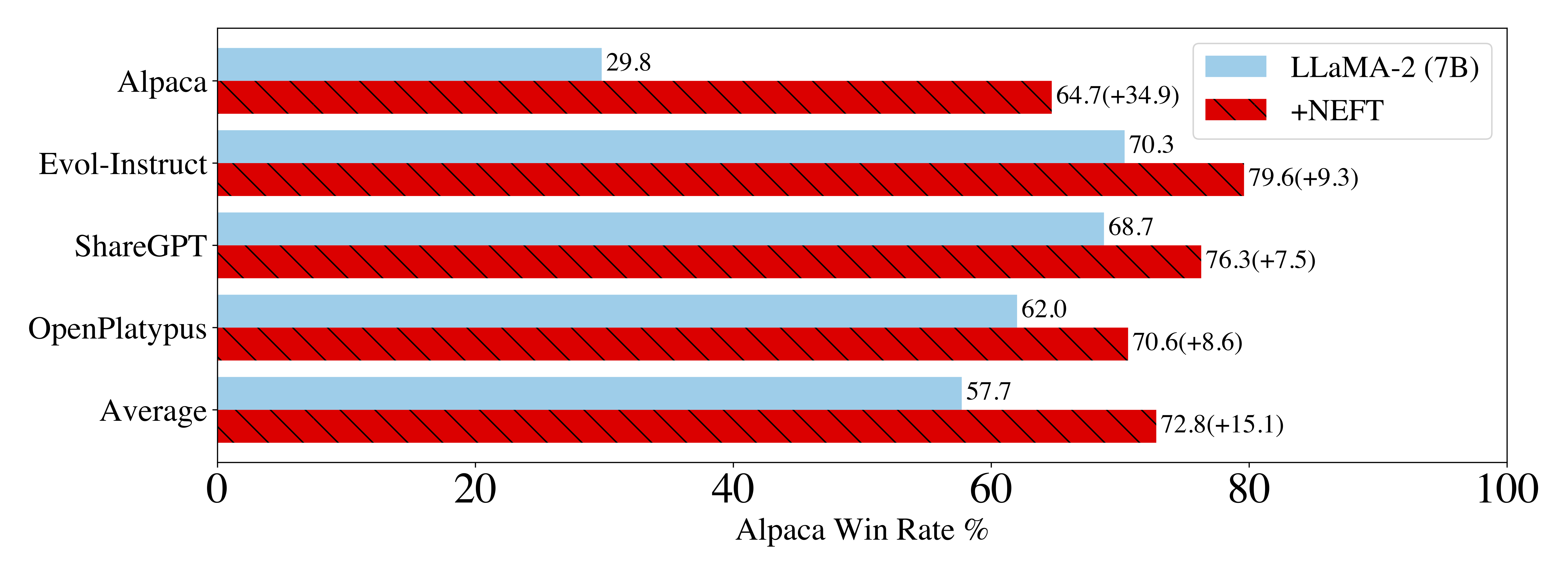[10/17/2023] NEFTune has been intregrated into the Huggingface's TRL (Transformer Reinforcement Learning) library. See Annoucement.
In this paper, we propose to add random noise to the embedding vectors of the training data during the forward pass of fine-tuning. We show that this simple trick can improve the outcome of instruction fine-tuning, often by a large margin, with no additional compute or data overhead. Noisy Embedding Instruction Fine Tuning (NEFTune), while simple, has a strong impact on downstream conversational quality. When a raw LLM like LLaMA-2-7B is finetuned with noisy embeddings with popular Alpaca dataset, its performance on AlpacaEval improves from 29.8% to 64.7% -- an impressive boost of around 35 percentage points. NEFTune leads to this surprising and large jump in performance on conversational tasks, maintaining performance on factual question answering baselines. Using noisy embeddings seems to be a free lunch for LLM fine-tuning. The paper can be found here.
The easiest way to incorporate NEFTune into your training procedure is to rewrite the forward for the embedding. An example of one way to do this for LLaMA is provided below. Note different distributed training will require different implementations.
from torch.nn import functional as F
def NEFTune(model, noise_alpha=5)
def noised_embed(orig_embed, noise_alpha):
def new_func(x):
# during training, we add noise to the embedding
# during generation, we don't add noise to the embedding
if model.training:
embed_init = orig_embed(x)
dims = torch.tensor(embed_init.size(1) * embed_init.size(2))
mag_norm = noise_alpha/torch.sqrt(dims)
return embed_init + torch.zeros_like(embed_init).uniform_(-mag_norm, mag_norm)
else:
return orig_embed(x)
return new_func
##### NOTE: this is for a LLaMA model #####
##### For a different model, you need to change the attribute path to the embedding #####
model.base_model.model.model.embed_tokens.forward = noised_embed(model.base_model.model.model.embed_tokens, noise_alpha)
return model
The code we used to run the experiments can be found in the experiment_code folder.
Our study has several limitations. We adopt AlpacaEval as our central measure of instruction following ability for LLMs, which is subject to the biases of a single judge (GPT-4). Additionally, due to limited computing resources, we were not able to validate the success of NEFTune on larger 70B variants of LLaMA-2 on multiple datasets, and we had to rely on fixed hyper-parameters for most NEFTune runs rather than sweeping. Finally, despite our empirical studies, we do not have a conclusive understanding of why NEFTune works.
Our study was limited to the settings that we explored. Please feel free to open an issue regarding any weakness of NEFTune. We hope to be open about any issues with NEFTune to help future research and users.
